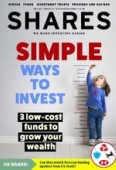Archived article
Please note that tax, investment, pension and ISA rules can change and the information and any views contained in this article may now be inaccurate.
A simple way to invest: 3 low-cost funds to grow your wealth

Do you want to start investing in an ISA without the hassle of researching lots of stocks? Exchange-traded funds (known as ETFs for short, or sometimes tracker funds) could be the solution as they are a low-cost and simple way to create a diversified portfolio.
In this article we talk about the benefits of using ETFs and build a hypothetical portfolio for someone looking to grow the value of their investments over the long term.
You don’t need to worry about any tax issues if you buy the ETFs inside an ISA as any profit you make from the investment is free from tax, so are dividend payments.
WHY USE ETFS?
ETFs are cheaper than traditional investment funds because they track an index of stocks and shares or other investments like bonds. There are rules that say what can go in the index, so the ETF just mirrors its performance.
For example, a FTSE 100 ETF would track the performance of the FTSE 100 index, which is a basket of the 100 biggest companies on the London Stock Exchange. If the FTSE 100 went up by 5% in a week, the ETF should do the same, in theory. There are very small charges to consider, so the ETF might lag the index by a tiny amount once charges are factored in.
A traditional investment fund, such as a unit trust, has a fund manager deciding what should go in and out of their portfolio and their fees tend to be much higher than an ETF. After all, you’re paying a person to manage the investments, whereas an ETF is just a computer following a set of rules.
HOW DO I MAKE MONEY?
When you buy an ETF, one way to make money is from your investment rising in value. If you sell the ETF at a higher price than you bought it, that’s known as a capital gain.
One of the benefits of investing is something called ‘compounding’. This is when you earn money based not just on the cash you invested at the outset but also on any gains you’ve made in the interim.
Let’s assume you achieve a 6% annual return on an initial £10,000 investment. At the end of the first year, your investment would be worth £10,600, or a gain of £600.

In the second year, the same 6% return on £10,600 would equate to a gain of £636 – higher than you got in the first year despite the same percentage return. At the end of that second year your initial £10,000 investment would be worth £11,236.
In the third year, a 6% annual return would equate to a gain of £674, meaning your original £10,000 is now worth £11,910.
One might have thought three years of investment at 6% a year would result in 18% total gain (3 x 6%). However, compounding has supercharged it, producing a gain of more than 19% in those three years.
If you tuck away your money for longer periods, say 10 or even 20 years, those compounding benefits really shine through.
PAY ATTENTION TO CHARGES
The figures in our example exclude costs – and costs really matter when you’re investing. If you invested £10,000 in an account and earned 6% a year for 25 years and had no costs or fees, you’d end up with around £43,000. Let’s say you paid a charge of 0.25% on the ETFs in your portfolio, after the same period you would still have a little over £40,000.
However, if you paid the 1% often charged by traditional actively managed funds, the same £10,000 investment would be worth less than £34,000 after 25 years. That’s why ETFs, with only modest fees, can be a lucrative long-term strategy, albeit there are no guarantees you will make money. It’s important to consider that you could even lose money with investing.
We do see merit in actively managed funds if the fund manager can add value through clever stock picking or portfolio management. But for the most straightforward and simple approach, ETFs can be the perfect solution to investors who want no-fuss exposure to the markets.
COLLECT OR REINVEST DIVIDENDS?
Often, you’ll see two versions of an ETF. One has the letters ‘INC’ in the product name and the other has ‘ACC’.
In a nutshell, the INC will pay you any dividends in cash and the ACC version will automatically reinvest dividends.
Buying the ACC version of an ETF is a good way to further boost the benefits of compounding.

WHERE DO I START?
Read on to discover three ETFs which could help someone aged 18 to 60 create a really good investment portfolio aimed at growing the value of their money rather than generating income. We’ll do a similar exercise for income ETFs in a future edition of Shares.
THREE ETFS TO BUY NOW
A report in 2010 by index provider MSCI suggested that investors may only need to look at three segments of the investment universe to have adequate allocation to global stock markets. These segments are:
• Developed markets large/mid cap
• Developed markets small cap
• Emerging markets
The term ‘cap’ stands for capitalisation. In plain English, it refers to the market value of a company. For example, a business valued at more than £10 billion is often referred to as a large cap. Mid-caps might be in the region of £2 billion to £10 billion, and small caps less than £2 billion.
If we follow MSCI’s suggestions, there are plenty of ETFs which provide exposure to each of these segments. Shares believes it is prudent to allocate more money to developed markets than emerging markets because the latter can be more volatile and higher risk.
An investor may therefore want to consider putting 55% of their money into a developed market large cap ETF, 30% into a developed
market small cap ETF and 15% into an emerging markets ETF.
Read on to discover our top picks (which are all ‘ACC’ versions of each ETF, so any dividends are automatically reinvested).
Large caps: Lyxor Core MSCI World ETF (LCWL) £11.28
Ongoing charge: 0.12%

The Lyxor ETF is an excellent starting point for an investor seeking diversified exposure to the stock market. It tracks the MSCI World index which is a basket of more than 1,500 stocks from across the developed world, including such names as Apple, Microsoft, Amazon and Tesla.

The average market value of stocks in the MSCI World index is $37.1 billion (£27 billion).
The US dominates the MSCI World index, with American stocks representing just over two thirds of all companies in the index.
Firms from Australia and New Zealand, across Europe as well as Singapore and Hong Kong also feature. Over the past three years this product has delivered an annualised return of 14.27%, according to data from Morningstar.
To find the ETF on your ISA provider’s platform, type in the code ‘LCWL’.
Small (and mid) caps: iShares MSCI World Small Cap ETF (WLDS) 539p
Ongoing charge: 0.35%

The iShares ETF tracks the MSCI World Small Cap index, which follows more than 4,400 stocks across 23 developed market countries.

The average value of companies in the index is $1.9 billion (£1.4 billion), yet the pack does include some larger businesses which means you’re getting some mid-cap exposure alongside smaller companies.
While the members are not necessarily household names, a key attraction of investing in smaller companies is getting exposure to businesses that will hopefully become better known in time.
The top positions in the index include software provider Bill.com and cookware-to-home furnishings group Williams Sonoma.
According to MSCI, the index has generated 12.81% annualised returns over the past decade. To find the ETF on your ISA provider’s platform, type in the code ‘WLDS’.
Emerging markets: iShares Core MSCI EM IMI ETF (EMIM) £26.59
Ongoing charge: 0.18%

Periods of significant volatility in emerging markets can detract from what is a more positive long-term picture.

Between 31 December 1987 and 30 September 2021, the underlying MSCI Emerging Market index delivered annualised returns of 11.7% compared with 9.6% for its developed economy counterpart the MSCI World. Five-year annualised returns from the iShares ETF are a more modest 7%.
Past performance is not necessarily guide to the future but there are drivers in place which could make emerging markets exposure attractive for an investor with a long-term investment timeframe.
These include a growing middle class which is boosting levels of domestic consumption, larger working age populations than in many Western countries and an increasing role for technology which is helping improve the quality of individual businesses.
Investors should be aware that China dominates the MSCI Emerging markets index with a weighting of more than 30% and among the top holdings are Chinese tech firms which have been victims of a recent crackdown by the authorities in Beijing.
Patience is required when investing in emerging markets as when life is going well, relevant stocks can do very well – but in tougher times, these markets can fall hard and fast. That’s why it is worth only having a small percentage of your money tied up in this area.
To find the iShares ETF on your ISA provider’s platform, type in the code ‘EMIM’.
DISCLAIMER: Co-author Daniel Coatsworth owns shares in iShares Core MSCI EM ETF
Important information:
These articles are provided by Shares magazine which is published by AJ Bell Media, a part of AJ Bell. Shares is not written by AJ Bell.
Shares is provided for your general information and use and is not a personal recommendation to invest. It is not intended to be relied upon by you in making or not making any investment decisions. The investments referred to in these articles will not be suitable for all investors. If in doubt please seek appropriate independent financial advice.
Investors acting on the information in these articles do so at their own risk and AJ Bell Media and its staff do not accept liability for losses suffered by investors as a result of their investment decisions.
Issue contents
Editor's View
Feature
Great Ideas
- XP Power lining up M&A drive
- Time to buy into SAP’s cloud shift before the market catches up
- Small cap consumer goods firm shrugs off supply chain issues
- Disney still a great long-term investment despite film delays
- Buy wholesaler Kitwave which is firmly in the driving seat
- QiniteQ sell-off represents a good buying opportunity
News
- What to expect in the latest updates from UK banks
- Life sciences property investor to break new ground
- Bitcoin ETF optimism feeds latest cryptocurrency rally
- Uranium’s glowing performance amid energy crisis
- ProCook and Stelrad plot main market flotations
- China could export inflation to the rest of the world

 magazine
magazine








